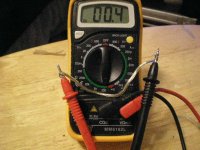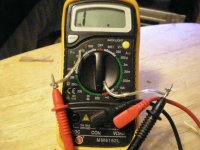New member here,was hoping you guys could help me out.I have a set of Eosone tower speakers which i've enjoyed for quite a while now.But one of the front dome tweeters is not working and i assumed its blown.I found a new one on ebay and alas it didnt work either.The wires that go to the tweeter are going down a little hole towards the bottom of the speaker,but they don't appear to be loose.Sure is frustrating.Is there maybe a fuse or a crossover that i could fix myself?Again thanks for any help it is much appreciated.Thanks, Jeff.
without knowing the speaker at all...
Is there a circuit breaker or accessible fuse somewhere on the back? Some speaker manufacturors do put fuses on the crossover board, outside the speaker, but many do not. Unless the connector panel in the back is rather large, chances are that the crossover board is seperate; you will have to remove a woofer to access the crossover board. From there, you'll have to be able to tell a fuse from a capacitor. If there are no fuses, then some more indepth troubleshooting is required, and unless you have a some simple electronic knowledge and soldering skills, you'll be lost, because this isn't anything that anyone will be able to step you through.
If you can provide front to back pics, that would be the first place to start.
Is there a circuit breaker or accessible fuse somewhere on the back? Some speaker manufacturors do put fuses on the crossover board, outside the speaker, but many do not. Unless the connector panel in the back is rather large, chances are that the crossover board is seperate; you will have to remove a woofer to access the crossover board. From there, you'll have to be able to tell a fuse from a capacitor. If there are no fuses, then some more indepth troubleshooting is required, and unless you have a some simple electronic knowledge and soldering skills, you'll be lost, because this isn't anything that anyone will be able to step you through.
If you can provide front to back pics, that would be the first place to start.
3-LockBox said:without knowing the speaker at all...
Is there a circuit breaker or accessible fuse somewhere on the back? Some speaker manufacturors do put fuses on the crossover board, outside the speaker, but many do not. Unless the connector panel in the back is rather large, chances are that the crossover board is seperate; you will have to remove a woofer to access the crossover board. From there, you'll have to be able to tell a fuse from a capacitor. If there are no fuses, then some more indepth troubleshooting is required, and unless you have a some simple electronic knowledge and soldering skills, you'll be lost, because this isn't anything that anyone will be able to step you through.
If you can provide front to back pics, that would be the first place to start.
I never thought of taking pics.,maybe i can do that.These are the really big and heavy tower speakers,that have the powered subs,so there are amps on the back.Maybe i'll try to remove the subs and see what i can see.Thanks for the reply.
I am sorry to state the obvious as you may kick yourself. Have you tried swapping the tweeters between the speakers to see if it is actually the tweeter that is broken? Make sure you remember or note which speaker cabinet had the working tweeter originally.
As your replacement tweeter did not work, I suspect that you will find that all your tweeters are in good order, in which case I would locate the crossover on the non-functioning cabinet and check for loose connections between the components and the circuit board. Often capacitors can work their way loose. These problemss are easy to correct with a soldering iron.
Good luck, and let us know how you get on.
As your replacement tweeter did not work, I suspect that you will find that all your tweeters are in good order, in which case I would locate the crossover on the non-functioning cabinet and check for loose connections between the components and the circuit board. Often capacitors can work their way loose. These problemss are easy to correct with a soldering iron.
Good luck, and let us know how you get on.
P.S. Don't remove your sub amp until you have tried my suggestion.
I assume your loudspeakers are powered by a normal amplifier/reciever/hifi as well as the sub plate amp. In this case your tweeter problem is very unlikely to be related to the active subs. Look for an issue with the passive crossover.
I assume your loudspeakers are powered by a normal amplifier/reciever/hifi as well as the sub plate amp. In this case your tweeter problem is very unlikely to be related to the active subs. Look for an issue with the passive crossover.
dublin78 said:I am sorry to state the obvious as you may kick yourself. Have you tried swapping the tweeters between the speakers to see if it is actually the tweeter that is broken? Make sure you remember or note which speaker cabinet had the working tweeter originally.
As your replacement tweeter did not work, I suspect that you will find that all your tweeters are in good order, in which case I would locate the crossover on the non-functioning cabinet and check for loose connections between the components and the circuit board. Often capacitors can work their way loose. These problemss are easy to correct with a soldering iron.
Good luck, and let us know how you get on.
Hi Dublin,yes i did try swapping the tweeters and the brand new one worked fine on the the good speaker,but not on the bad one.Its just weird to me that every other speaker component is working fine even the rear side tweeter,but i am a newbie to how a speaker works so that maybe why.Anyway,i do want to to try and locate the crossover but i'm not sure the best way to go about it.Should i remove the subs from the front since they are on the bottom of the speaker?It seems like i would be able to get to the crossover that way.Lmk what you think.Thanks again.
JH74 said:
Anyway,i do want to to try and locate the crossover but i'm not sure the best way to go about it.Should i remove the subs from the front since they are on the bottom of the speaker?It seems like i would be able to get to the crossover that way.Lmk what you think.Thanks again.
If one of the subwoofers are directly behind the input terminals, that’s where I would start. If the crossover not there, at least you can follow the wires
An externally hosted image should be here but it was not working when we last tested it.
Ok,here is a picture of the crossover.I've tried to check all the wires and i can't find anything loose anywhere.Hope this helps you guys,i appreciate your thoughts.
Doesn't look like any sort of protection there (vdr etc).
I'd undo those four black screws and have a look for bad solder joints.
(again a pic will help)
After that I'd be looking at testing/replacing the wires from the xover to that tweeter.
If it's only one tweeter out of two, it would sound more like a broken wire/joint.
I'd undo those four black screws and have a look for bad solder joints.
(again a pic will help)
After that I'd be looking at testing/replacing the wires from the xover to that tweeter.
If it's only one tweeter out of two, it would sound more like a broken wire/joint.
JH74 said:One more thing i want to mention,this speaker has the exact same tweeter on the back side,for whatever reason,but it is still working.That just seems odd,i wish it was the back one not working,lol,then i wouldnt mind so much.
If the rear tweeter is not attenuated, you can always switch wire of one tweeter to the other. If you do this the wire has to be reversed (instead of + connected to +, it will be + connected to -).
My money's on the w/w resistor (the rectangular white component) being open circuit or dry jointed.
It looks as if it's been quite hot (that's OK - it's meant to), which may well have spoilt the solder that connects it.
Remove the board, and wiggle the resistor, looking for movement in the joint underneath. If there's any doubt, resolder it - preferably removing the old solder first. Also check the resistance with a meter - it should be quite low (see what's wrtten on the body, if it's still legible). If it's more than a few hundred Ohms, replace the resistor.
It looks as if it's been quite hot (that's OK - it's meant to), which may well have spoilt the solder that connects it.
Remove the board, and wiggle the resistor, looking for movement in the joint underneath. If there's any doubt, resolder it - preferably removing the old solder first. Also check the resistance with a meter - it should be quite low (see what's wrtten on the body, if it's still legible). If it's more than a few hundred Ohms, replace the resistor.
I'm going to attempt to remove the board and look for loose joints.Unfortunatley i'm pretty bare bones and don't even own a solder gun,or multimeter.Would a mutimeter tell me if the wires are bad?I'm not sure how they work.If i can't find anything i might just have to live with this,unless i can find someone local.Thanks guys.
JH74 said:.Would a mutimeter tell me if the wires are bad?I'm not sure how they work.
Yes it would
This is a picture of a cheap multimeter measuring the resistance of a good peice of wire. A good piece of wire is less one ohm.
Attachments
This is a picture of the multimeter with a cut(equal to a burned or faulty wire) piece of wire. Notice in this picture there are no numbers showing,(pay no attention to the number 1 on the far left),this means the resistance is very high(The ohm / resistance are near infinite)and no electron flow.
Attachments
- Status
- This old topic is closed. If you want to reopen this topic, contact a moderator using the "Report Post" button.
- Home
- Loudspeakers
- Multi-Way
- How to take apart a home tower speaker?

